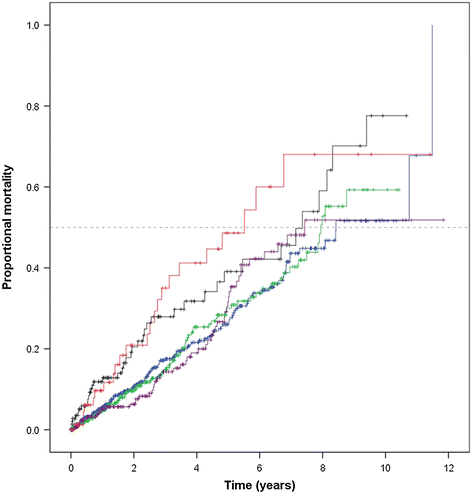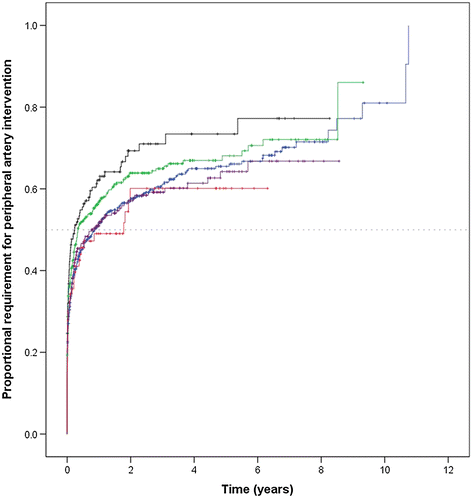Association of impaired fasting glucose, diabetes and their management with the presentation and outcome of peripheral artery disease: a cohort study - PubMed (original) (raw)
Association of impaired fasting glucose, diabetes and their management with the presentation and outcome of peripheral artery disease: a cohort study
Jonathan Golledge et al. Cardiovasc Diabetol. 2014.
Abstract
Background: Pre-diabetes and untreated diabetes are common in patients with peripheral artery disease however their impact on outcome has not been evaluated. We examined the association of impaired fasting glucose, diabetes and their treatment with the presentation, mortality and requirement for intervention in peripheral artery disease patients.
Methods: We prospectively recruited 1637 patients with peripheral artery disease, measured fasting glucose, recorded medications for diabetes and categorised them by diabetes status. Patients were followed for a median of 1.7 years.
Results: At entry 22.7% patients were receiving treatment for type 2 diabetes by oral hypoglycaemics alone (18.1%) or insulin (4.6%). 9.2% patients had non-medicated diabetes. 28.1% of patients had impaired fasting glucose (5.6-6.9 mM). Patients with non-medicated diabetes had increased mortality and requirement for peripheral artery intervention (hazards ratio 1.62 and 1.31 respectively). Patients with diabetes prescribed insulin had increased mortality (hazard ratio 1.97). Patients with impaired fasting glucose or diabetes prescribed oral hypoglycaemics only had similar outcomes to patients with no diabetes.
Conclusions: Non-medicated diabetes is common in peripheral artery disease patients and associated with poor outcomes. Impaired fasting glucose is also common but does not increase intermediate term complications. Peripheral artery disease patients with diabetes requiring insulin are at high risk of intermediate term mortality.
Figures
Figure 1
Kaplan Meier curves showing the cumulative proportional mortality in relation to diabetes categories. Lines represent mortality for subjects grouped by diabetes categories. The blue, green, black, purple and red lines represent no diabetes, impaired fasting glucose, non-medicated diabetes, diabetes prescribed oral hypoglycaemics only and diabetes prescribed insulin, respectively. Vertical lines represent subjects censored at loss to follow-up.
Figure 2
Kaplan Meier curves showing the cumulative proportional requirement for peripheral artery intervention in relation to diabetes categories. Lines represent requirement for peripheral artery intervention for subjects grouped by diabetes categories. The blue, green, black, purple and red lines represent no diabetes, impaired fasting glucose, non-medicated diabetes, diabetes prescribed oral hypoglycaemics only and diabetes prescribed insulin, respectively. Vertical lines represent subjects censored at loss to follow-up.
Similar articles
- A pilot study to examine the feasibility of insulin glargine in subjects with impaired fasting glucose, impaired glucose tolerance or new-onset type 2 diabetes.
Marbury TC, Schwartz S, Rosenberg MA, Jariwala N, Becker RH, Johnston PS. Marbury TC, et al. Exp Clin Endocrinol Diabetes. 2008 May;116(5):282-8. doi: 10.1055/s-2007-1022521. Exp Clin Endocrinol Diabetes. 2008. PMID: 18484560 Clinical Trial. - Self-monitoring of blood glucose in type 2 diabetes and long-term outcome: an epidemiological cohort study.
Martin S, Schneider B, Heinemann L, Lodwig V, Kurth HJ, Kolb H, Scherbaum WA. Martin S, et al. Diabetologia. 2006 Feb;49(2):271-8. doi: 10.1007/s00125-005-0083-5. Epub 2005 Dec 17. Diabetologia. 2006. PMID: 16362814 - Sex-specific clinical outcomes of impaired glucose status: A long follow-up from the Tehran Lipid and Glucose Study.
Parizadeh D, Rahimian N, Akbarpour S, Azizi F, Hadaegh F. Parizadeh D, et al. Eur J Prev Cardiol. 2019 Jul;26(10):1080-1091. doi: 10.1177/2047487319834396. Epub 2019 Mar 12. Eur J Prev Cardiol. 2019. PMID: 30862232 - Metformin use among individuals at risk for type 2 diabetes.
Kuller LH. Kuller LH. Curr Diab Rep. 2012 Jun;12(3):265-73. doi: 10.1007/s11892-012-0263-x. Curr Diab Rep. 2012. PMID: 22399368 Review. - Therapeutic implications of diabetes in cardiovascular disease.
Cherian B, Meka N, Katragadda S, Arora R. Cherian B, et al. Am J Ther. 2009 Nov-Dec;16(6):e51-9. doi: 10.1097/MJT.0b013e31815db924. Am J Ther. 2009. PMID: 19940606 Review.
Cited by
- Association of remoteness and ethnicity with major amputation following minor amputation to treat diabetes-related foot disease.
Alahakoon C, Thanigaimani S, Singh TP, Drovandi A, Charles J, Fernando M, Lazzarini PA, Moxon JV, Golledge J. Alahakoon C, et al. PLoS One. 2024 Jul 5;19(7):e0302186. doi: 10.1371/journal.pone.0302186. eCollection 2024. PLoS One. 2024. PMID: 38968185 Free PMC article. - Microvascular and Endothelial Dysfunction in Prediabetes.
Lamprou S, Koletsos N, Mintziori G, Anyfanti P, Trakatelli C, Kotsis V, Gkaliagkousi E, Triantafyllou A. Lamprou S, et al. Life (Basel). 2023 Feb 25;13(3):644. doi: 10.3390/life13030644. Life (Basel). 2023. PMID: 36983800 Free PMC article. Review. - Update on the pathophysiology and medical treatment of peripheral artery disease.
Golledge J. Golledge J. Nat Rev Cardiol. 2022 Jul;19(7):456-474. doi: 10.1038/s41569-021-00663-9. Epub 2022 Jan 7. Nat Rev Cardiol. 2022. PMID: 34997200 Review. - Phenotyping the Prediabetic Population-A Closer Look at Intermediate Glucose Status and Cardiovascular Disease.
Barbu E, Popescu MR, Popescu AC, Balanescu SM. Barbu E, et al. Int J Mol Sci. 2021 Jun 25;22(13):6864. doi: 10.3390/ijms22136864. Int J Mol Sci. 2021. PMID: 34202289 Free PMC article. Review. - Control of modifiable risk factors and major adverse cardiovascular events in people with peripheral artery disease and diabetes.
Golledge J, Drovandi A, Rowbotham S, Velu R, Quigley F, Jenkins J. Golledge J, et al. World J Diabetes. 2021 Jun 15;12(6):883-892. doi: 10.4239/wjd.v12.i6.883. World J Diabetes. 2021. PMID: 34168735 Free PMC article.
References
- European Stroke Organisation. Tendera M, Aboyans V, Bartelink ML, Baumgartner I, Clément D, Collet JP, Cremonesi A, De Carlo M, Erbel R, Fowkes FG, Heras M, Kownator S, Minar E, Ostergren J, Poldermans D, Riambau V, Roffi M, Röther J, Sievert H, van Sambeek M, Zeller T, ESC Committee for Practice Guidelines ESC Guidelines on the diagnosis and treatment of peripheral artery diseases: Document covering atherosclerotic disease of extracranial carotid and vertebral, mesenteric, renal, upper and lower extremity arteries: the Task Force on the Diagnosis and Treatment of Peripheral Artery Diseases of the European Society of Cardiology (ESC) Eur Heart J. 2011;32(22):2851–2906. doi: 10.1093/eurheartj/ehr211. - DOI - PubMed
- Belch JJ, Topol EJ, Agnelli G, Bertrand M, Califf RM, Clement DL, Creager MA, Easton JD, Gavin JR, 3rd, Greenland P, Hankey G, Hanrath P, Hirsch AT, Meyer J, Smith SC, Sullivan F, Weber MA, Prevention of Atherothrombotic Disease Network Critical issues in peripheral arterial disease detection and management: a call to action. Arch Intern Med. 2003;163(8):884–892. doi: 10.1001/archinte.163.8.884. - DOI - PubMed
- Federation ID. IDF Diabetes Atlas. 6. Brussels, Belgium: International Diabetes Federation; 2013. - PubMed
Publication types
MeSH terms
Substances
LinkOut - more resources
Full Text Sources
Other Literature Sources
Medical

